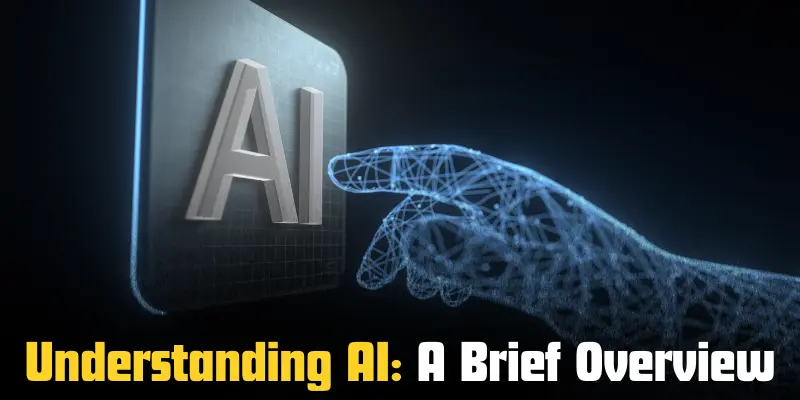Uses of AI: How Artificial Intelligence Transforms Life
Published: 5 Feb 2025
Introduction
Did you know that every time you ask your voice assistant for the weather, or get a movie suggestion on Netflix, you’re interacting with Artificial Intelligence (AI)? It’s true—AI is everywhere, and it’s shaping the way we live, work, and play.
In simple terms i will explain Uses of AI to all of you, Artificial Intelligence refers to machines and software that can think, learn, and make decisions—just like humans. It’s the technology behind your phone’s voice assistant, your favorite streaming service’s recommendations, and even self-driving cars.
AI is no longer a futuristic idea; it’s deeply integrated into our daily lives. From healthcare to business, AI is making tasks quicker, easier, and more personalized. It’s transforming entire industries and is poised to revolutionize the way we interact with the world around us. The more we understand AI, the better we can use it to enhance our daily experiences and solve real-world challenges.
Understanding AI: A Brief Overview

What is AI?
Artificial Intelligence (AI) is a technology that enables machines and software to perform tasks that typically require human intelligence. Think of it as creating “smart” machines that can think, learn, and make decisions on their own.
- Machines that Think: AI can simulate human thinking. This means it can analyze problems, make decisions, and even predict future outcomes.
- Learning from Experience: Just like humans, AI systems can “learn” from their experiences and improve over time without needing to be reprogrammed.
- Performing Tasks: AI can do a wide variety of tasks, like recognizing speech, making recommendations, and even driving cars!
How AI Works
AI works by using data to “learn” patterns and make decisions. Let’s break it down:
- Machine Learning (ML): This is a key part of AI. It’s the process where machines use large amounts of data to learn and improve without being directly programmed. Imagine teaching a child to recognize animals. The more pictures of cats and dogs they see, the better they can identify new animals.
- Data Processing: AI uses huge sets of data (like images, texts, or numbers) to recognize patterns. For example, by analyzing past weather data, AI can predict future weather conditions.
- Neural Networks: This is how AI mimics the brain. Neural networks help machines process complex information, like how a human brain recognizes a face, voice, or object.
Tip: A Simple Analogy
Think of AI as a child learning to recognize different objects. When a child sees an apple for the first time, they might not know what it is. But after being shown several apples, the child can recognize an apple the next time they see it. AI works in the same way—it learns from data, and with more examples, it becomes smarter.
Common Uses of AI in Everyday Life
Voice Assistants (e.g., Siri, Alexa, Google Assistant)
AI powers virtual assistants that recognize your voice and understand commands to perform tasks for you.
- Speech Recognition: AI listens to your voice and converts what you say into text. It can then figure out what you want based on the words you use.
- Natural Language Processing (NLP): AI understands the meaning behind your words, even if you speak in full sentences or ask questions.
- Learning Your Preferences: The more you interact with voice assistants, the better they get at understanding your needs. For example, your assistant might learn your favorite music or when to remind you about an upcoming meeting.
- Task Automation: Voice assistants can set reminders, play music, control smart devices, or provide weather updates—all through simple voice commands.
Recommendation Systems (e.g., Netflix, YouTube, Amazon)
AI helps recommend movies, shows, or products by analyzing your past behavior and preferences.
- Analyzing Past Behavior: AI looks at what you’ve watched, liked, or purchased before to understand your tastes and make personalized suggestions.
- Predicting What You’ll Like: Based on patterns, AI predicts what new content or products you might enjoy and presents them to you.
- Continuous Learning: The more you interact with recommendation systems, the better AI gets at offering suggestions that match your preferences.
- Enhanced User Experience: AI recommendations keep you engaged by offering content tailored to your interests, making it easier to discover new things you’ll enjoy.
Smart Home Devices
AI powers smart home devices, making everyday tasks easier by automating actions based on your preferences and routines.
- Voice-Controlled Devices: Smart speakers like Alexa or Google Home allow you to control your lights, thermostat, and even your coffee maker with simple voice commands.
- Learning Your Schedule: AI in smart thermostats (like Nest) learns your daily routine, adjusting the temperature automatically when you wake up, leave for work, or go to bed.
- Security Systems: AI-powered security cameras can detect motion, recognize faces, and even alert you if something unusual happens at home.
- Energy Efficiency: AI optimizes the use of electricity in your home, reducing energy waste by adjusting lighting and temperature settings based on your habits.
AI in Business and Industry
Customer Support (Chatbots)
AI is revolutionizing customer service by powering chatbots that can handle inquiries around the clock.
- 24/7 Availability: AI-powered chatbots can answer customer questions at any time of day, even when human agents are unavailable.
- Instant Responses: Chatbots provide immediate answers, helping customers solve problems quickly without waiting in long queues.
- Handling Common Inquiries: AI chatbots are designed to answer frequently asked questions, such as “Where is my order?” or “What are your business hours?”
- Learning from Conversations: Over time, chatbots improve by learning from customer interactions, becoming more accurate and efficient in resolving issues.
Data Analysis and Insights
AI helps businesses process large amounts of data and generate insights that support smarter decision-making.
- Identifying Patterns: AI analyzes huge datasets to uncover trends and patterns that humans might miss, helping businesses understand customer behavior, market conditions, and more.
- Predictive Analytics: AI can predict future trends, such as sales forecasts or demand spikes, based on past data and patterns.
- Personalized Marketing: By analyzing customer data, AI helps companies create targeted ads and offers that are more likely to appeal to specific audiences.
- Improving Efficiency: AI can sift through complex data faster than humans, making it easier for businesses to spot opportunities and risks quickly.
Automation of Repetitive Tasks
AI automates routine business tasks, freeing up time for employees to focus on more important work.
- Inventory Management: AI systems can track inventory levels, automatically order products when stocks are low, and predict future demand.
- Automated Billing and Invoicing: AI handles repetitive administrative tasks like generating invoices, processing payments, and managing subscriptions.
- Employee Scheduling: AI helps businesses create employee schedules, considering factors like availability, shift preferences, and labor laws.
- Document Sorting and Processing: AI can quickly sort through emails, contracts, and documents to find important information, reducing manual effort.
AI in Healthcare

AI for Disease Detection
AI helps doctors detect diseases early by analyzing medical images and data much faster and more accurately than humans.
- Analyzing X-rays and MRIs: AI uses algorithms to study medical images like X-rays and MRIs to spot signs of diseases such as cancer, pneumonia, or fractures.
- Detecting Patterns in Data: AI can recognize tiny patterns in images that may be too subtle for the human eye, improving the accuracy of diagnoses.
- Speed and Efficiency: AI can process thousands of images in minutes, helping doctors make quicker decisions about treatments.
- Early Diagnosis: AI helps in early disease detection by identifying issues in the earliest stages, which can lead to more effective treatments.
Example: “AI has even helped doctors detect cancer earlier by analyzing medical images faster than a human could.”
AI in Personalized Medicine
AI creates custom treatment plans by analyzing a patient’s unique medical data, improving the effectiveness of treatments.
- Analyzing Patient Data: AI looks at a patient’s medical history, genetic information, and lifestyle to create a treatment plan tailored to their needs.
- Predicting Treatment Success: AI can predict how well a patient will respond to a specific treatment based on similar cases and data.
- Adjusting Treatments Over Time: As a patient’s condition changes, AI can adjust the treatment plan to better suit their evolving needs.
- Reducing Trial and Error: With AI’s insights, doctors can avoid unnecessary treatments and find the most effective options more quickly.
Drug Discovery and Research
AI speeds up the process of discovering new drugs by analyzing vast amounts of data and predicting potential treatments.
- Analyzing Medical Data: AI examines large datasets of molecular and genetic information to find potential drug candidates that could treat diseases.
- Simulating Drug Reactions: AI can simulate how different drugs interact with the human body, speeding up the testing phase.
- Identifying New Drug Compounds: AI can predict which compounds might work best in treating diseases, reducing the time it takes to develop new medications.
- Accelerating Research: By automating the analysis process, AI allows researchers to test and analyze drug candidates faster, bringing new treatments to market more quickly.
AI in Education
Personalized Learning Tools
AI-powered tools tailor lessons to fit each student’s unique learning style, helping them learn at their own pace.
- Adapting to Individual Needs: AI adjusts lessons based on how well a student is performing, ensuring the material is neither too easy nor too hard.
- Custom Learning Paths: AI creates personalized learning paths, focusing on areas where the student needs improvement, while progressing faster in areas they excel in.
- Learning Style Adaptation: AI can analyze whether a student learns best through reading, visuals, or interactive exercises, and adjust lessons accordingly.
- Real-Time Feedback: As students interact with learning tools, AI provides instant feedback, helping them understand concepts more clearly and fix mistakes quickly.
Automated Grading
AI helps teachers save valuable time by grading assignments and exams automatically, allowing them to focus on teaching.
- Speedy Grading: AI can grade multiple-choice, short-answer, and even essays much faster than teachers could by hand.
- Consistency and Accuracy: AI ensures that grading is consistent across all students, removing human error or bias from the process.
- Detailed Insights: Teachers can receive reports on student performance, identifying areas where students may be struggling and need extra attention.
- Time-Saving: By automating the grading process, AI gives teachers more time to focus on lesson planning, student engagement, and personalized instruction.
Virtual Tutors
AI-powered virtual tutors help students learn difficult subjects by offering extra support and personalized assistance.
- On-Demand Help: Virtual tutors are available 24/7, so students can get help whenever they need it, without having to wait for office hours.
- Personalized Assistance: AI tutors adjust their teaching methods to the student’s needs, whether that’s explaining a concept in a simpler way or providing additional practice problems.
- Interactive Learning: Many virtual tutors offer quizzes, games, and interactive exercises that keep students engaged while helping them master challenging subjects.
- Supplementing Classroom Learning: AI tutors work alongside traditional classroom instruction, providing extra practice and reinforcing what students learn in school.
Conclusion
So guys, in this article, we’ve covered Uses of AI in detail. As we’ve seen, AI is already having a profound impact on everything from healthcare to business and even entertainment.
My personal recommendation? Stay curious and explore how AI can improve your life—whether it’s for productivity, convenience, or simply making tasks more enjoyable.
It’s an exciting time to be learning about AI, and there’s so much potential in how we can use it to solve real-world problems.

- Be Respectful
- Stay Relevant
- Stay Positive
- True Feedback
- Encourage Discussion
- Avoid Spamming
- No Fake News
- Don't Copy-Paste
- No Personal Attacks

- Be Respectful
- Stay Relevant
- Stay Positive
- True Feedback
- Encourage Discussion
- Avoid Spamming
- No Fake News
- Don't Copy-Paste
- No Personal Attacks



